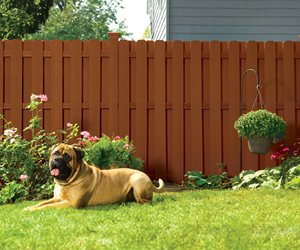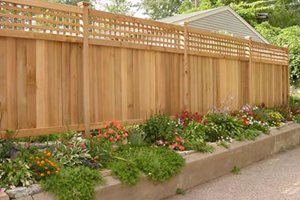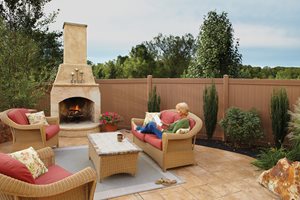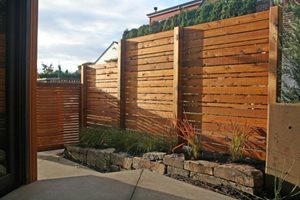Composite Fencing
Composite lumber fence posts and panels are a long lasting alternative to wood.The world of "plastic" fencing is dominated by vinyl, but in the last five years a whole new branch of this industry is producing a different product that's quite similar except that it uses composite lumber to construct fencing. In the beginning when composite recycled "plastic" lumber became widely available, it proved a long lasting alternative to wood fence posts. So naturally this dense, long lasting recycled lumber would be equally well suited to the rest of the fence too.
What makes it differ from vinyl is that composite lumber is 50% recycled plastic and 50% recycled wood product. Some brands even boast 95% recycled content. For this reason, those looking for greener alternatives may find this material a more appealing choice than all new plastic vinyl (PVC).
Composite fencing can be constructed from composite lumber just like a wood fence is made, but it will cost three times more.
In general, composite fence lumber is about equal in cost to that of redwood, the most expensive of all fencing woods. A fence of treated fir will run about a third of the price of a composite fence. However, compared to wood, a composite fence will never rot out and is likely to outlive the homeowner, with no special care or maintenance over the years. This is a huge factor in areas with a long rainy season where wood products are prone to rot, or where other climatic features shorten the life span of wood fences.
Top Composite Fence Manufacturers
- Trex
- Fiberon
- TimberTech
- Simtek
Fence Systems
Like vinyl, there are fledgling companies developing composite made fencing systems. They will not offer the range of colors and styles as vinyl simply because they are so new. These systems utilize composite materials that are specially formulated to be more lightweight than composite lumber, which is significantly heavier than wood. They may also include stringers and other high pressure components of the fence made with a steel core inside to reduce the sag that can afflict some forms of vinyl fencing.
The systems reduce the amount of material used to make the fence, thereby reducing the overall cost. Fence systems may be the only way to obtain composite fencing in unique colors and surface textures like those of vinyl, due to limited availability. Both composite and vinyl do not accept paint, therefore the colors are life long and may not be changed in the future.
When considering a composite fence, take special care to see the product material in natural light. Are the fence colors available natural looking? Do you want the fence to look painted with solid colors? This may be the chief issue of these fences until the industry catches up with the vinyl market which is working hard to create their own lines that resemble the wood look of composite. Consider this list of important issues before selecting a composite fence design or system:
- Investigate the company to determine if its products have a long enough period of testing in residential conditions.
- Does it manufacture its composite and if so, how is it different from other composite lumber brands?
- Will the fence be made from scratch with composite lumber, or is it a system that is only available from that single manufacturer?
- Are the colors truly realistic and do they look like wood?
- Are there any examples of these fences in your area that have age to verify colorfastness of that brand in your local climate?

 Backyards
Backyards
 Front Yards
Front Yards






